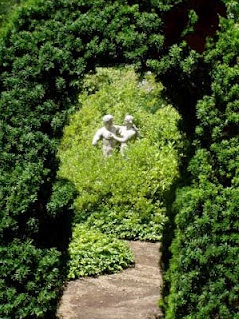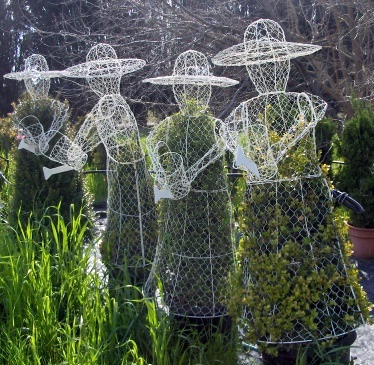Categories
Calendars
Guides
Reviews
Archive
Gallery
Articles
Ask Our Gardening Expert
Topiary
Architectural and geometric shapes are traditionally produced and the practice has developed into forming more whimsical shapes in the form of birds, animals, furniture and machinery. They can add a dramatic or even an outlandish addition to any garden as long they are displayed in an open space to help appreciation. Using strong, geometric shapes, like columns, spheres and pillars, we can add a structural element to design. In formal gardens, topiary can be used to frame a view, provide a ‘surprise’ or lead the visitor. In informal gardens, they can form a contrast to less structured plantings. Topiary is also effective in containers, using a single plant as a centrepiece, a pair either side of a doorway or to line a pathway.
Topiary can be used to ‘frame’ views or create surprise
Ideal topiary plants need to be flexible, have dense growth, small leaves and recover easily from clipping. Preferred temperate climate evergreens include yew (Taxus baccata) , box (Buxus) and Lonicera nitida. In warmer climates, Cupressus sempervirens can be trained. Ivies can be encouraged to grow over a framework.
Some elaborate topiary frames
Topiary needs more precision than hedge clipping. Cutting too much can spoil the shape and it is a good idea to step back frequently for a quick assessment. Hasty cutting may make one have to wait for the following season to make a repair. Use levels, tape measures, rulers and plumblines to check accuracy. Work from the top to the bottom and from the centre outwards. Spherical shapes are easier than geometric shapes.
A large number of trees and shrubs can be manipulated to grow into a variety of shapes and forms. Training and pruning trees to form attractive and sometimes, strange shapes has been carried out since Roman times.
It is far better to have a framework to help cutting to shape. It can be done freehand but it is better to start out with a firm idea. A frame or guide will help maintain the development of the form until it is completed.
Start with young plants. Choose a stem or stems that will be the foundation of the design. A cone shape can be formed by a ‘wigwam’ of canes, retained and brought out when clipping is due. A cuboid can be formed with the help of twelve lengths of timber fixed to form a solid rectangular shape. More complicated shapes require a framework of fencing wire or chicken wire. Young stems grow quickly and new shoots must be tied in frequently. 
Clip several times a season when the form is established. Trim when new growth seems uneven. The same care is needed for topiary shapes as for normal shrubs and trees. Water, mulch and fertilise as needed. Check potted topiary to check for drying out. If a leader or branch is damaged, cut it back with secateurs and bend in nearby shoots to fill the gap. Plants that have not been clipped for a year or two, regular clipping should restore the plant to shape.